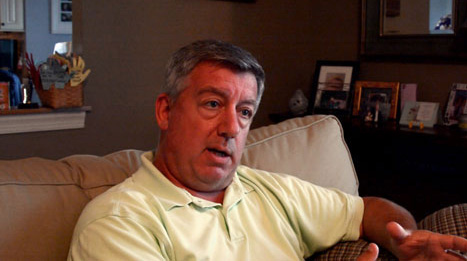NEW WINDSOR – Maryland’s five western counties have had enough.
Allegany, Carroll, Frederick, Garrett, and Washington counties are ready to sever ties with the Free State and start their own, according to Scott Strzelczyk, a 49-year-old information technology consultant and self-proclaimed leader of the Western Maryland Initiative.
“I think our differences are irreconcilable and ultimately we want an amicable divorce,” said Strzelczyk.
Strzelczyk, a resident of the rural town of New Windsor in Carroll County, said three things prompted him to create the group: gerrymandering of Western Maryland’s congressional district, tax increases and recent legislation limiting firearm sales in the state.
The Facebook page Strzelczyk launched to garner support for the cause, titled ‘Western Maryland: A New State Initiative,’ currently has more than 6,000 ‘likes’.
“We don’t need Annapolis telling us how to live our lives and telling us what’s right for us and what isn’t right for us,” Strzelczyk said.

Similar secessionist movements, led by citizens fed up with their state government, have sprung up throughout the country in states like Alaska, California, Colorado, Hawaii, New York and New Hampshire.
A group of conservatives in rural Northern California want to create the 51st state which they’ve named ‘Jefferson’. The organization’s website promotes smaller government and lower taxes.
The Texas Nationalist Movement, which counts over 250,000 in supporters, wants to cut ties with the U.S. altogether and see Texas become its own independent nation, according to the organization’s website.
And in 1972 former Republican state Sen. Bob Bauman, led an unsuccessful effort to make the Eastern Shore its own independent state.
“I can sympathize with the mountain men of Western Maryland,” said Bauman, who also served in Congress. He now lives in the south Florida community of Wilton Manors, after losing a 1980 re-election bid due to a sex scandal with a male teenager.
“[Gov. Martin] O’Malley and the Democrats only care about the Baltimore-Washington region,” he said.
While the majority of Maryland voted to elect President Obama in 2008 and 2012, the five western counties voted for the McCain-Palin ticket in 2008 and the Romney-Ryan ticket in 2012, according to Maryland State Board of Elections results.
The five counties are more rural and white than the rest of Maryland. According to 2010 Census data, the counties are nearly 90 percent white, in comparison to rest of the state, which has a 58.2 percent white population overall.
Residents of these red counties were unhappy when redistricting of the 6th Congressional District resulted in the loss of a Republican representative.
Republican Roscoe Bartlett represented the district for 20 years before Montgomery County Democrat John Delaney won the seat last year after the district was redrawn to incorporate parts of Montgomery County.
Bartlett said of losing his seat to Delaney, “Of course it was the result of gerrymandering.”
“It’s very clear that all the parts of Maryland, the Eastern Shore…all of Western Maryland – they are not represented in Annapolis,” Bartlett said.
Many agree gerrymandering of the 6th Congressional District has led to a feeling of alienation by Western Marylanders. Gerrymandering, or dividing a geographic area into voting districts that gives one political party an unfair advantage in elections, has been done by both parties throughout the U.S.
Two or three of the largest gerrymandered districts in the country are in Maryland, including the 6th Congressional District, said Todd Eberly, Assistant Professor of Political Science at St. Mary’s College.
“It was a strategy to minimize the impact of Republicans,” he said.
While Eberly agrees that redistricting of these counties was unfair, he doesn’t think seceding from the state is a good solution.
“If we go around breaking up into little tribes…there’s not really a good future for our country,” he said.
Eberly says making redistricting a partisan process by allowing public panels to draw district lines, rather than politicians would ensure fairness.
David Karol, Associate Professor of Government and Politics at University of Maryland, says he doesn’t see Western Maryland achieving its independence anytime soon.
“I think we’re talking about a small group of people,” he said. “It’s less than one percent of the population [of the five counties] he’s appealing to.”
In order to secede from the state, Western Maryland would need Congressional approval, which Karol says is unlikely to happen.
“They’re on the losing end of politics of the state and that’s not fun for anybody, “ Karol said.
“There’s no evidence they’ve thought this through,” he said, although Strzelczyk would disagree with such a statement.
So, how does the Western Maryland Initiative plan to fund a new state?
Strzelczyk who is in the process of gaining nonprofit status for the group said in an e-mail, “We will put together a policy committee to evaluate and assess this.”
He would want the new state to be more business friendly and proposes no corporate income tax, he said.
“Perhaps lower sales taxes and state taxes (or maybe only one of those two) will keep more money in the pockets of the people that earned it,” he wrote.
“It’s not the government supporting itself that is the concern, it is can the people support themselves economically. I [certainly] don’t see that changing significantly because people will still go to work where they are employed whether that is within the boundaries of the new state or…elsewhere,” he wrote. “Much of this is predicated upon what the ‘new state’ will look like. Until that is defined, it’s difficult to say precisely what revenue is needed to fund it.”
Regardless of whether Western Maryland achieves statehood or not, Bartlett says the group is educating people about representation.
“It’s very difficult for a government to serve the interests of people if they’re so different,” Bartlett said.


You must be logged in to post a comment.